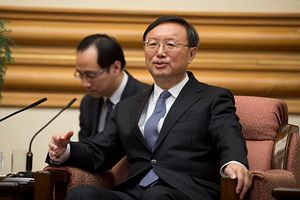While much attention at the 2015 Boao Forum for Asia this weekend was lavished on China’s 21st Century Maritime Silk Road and other grand proposals, Beijing also held a ceremony on the sidelines of the forum to officially launch the Year of ASEAN-China Maritime Cooperation.
Last year, Chinese leaders repeatedly proposed making 2015 the year of ASEAN-China maritime cooperation. This is not entirely new – ASEAN and China have been talking about how to foster maritime cooperation for a while now, with Beijing unveiling a China-ASEAN Maritime Cooperation Fund in 2011. But 2015 was supposed to mark a landmark year that would highlight ASEAN-China cooperation this area and tie it in with the development of the 21st Century Maritime Silk Road.
In doing so, Beijing had hoped to shift the attention away from conflict in the South China Sea, which it calculates is only a concern to the four ASEAN claimant states – Brunei, Malaysia, the Philippines and Vietnam – and perhaps a few other interested parties, to more cooperative outcomes that benefit all. Focusing on financing projects would also enable Beijing to woo some ASEAN states with the win-win logic of cooperation to offset the times it scares them with its growing assertiveness in disputed areas. Not all ASEAN countries need to be convinced of this – just enough to keep ASEAN as a grouping divided on both the South China Sea issue itself as well as how to address issues moving forward.
How exactly would this be accomplished? In a speech at the launch of the Year of ASEAN-China Maritime Cooperation this weekend, China’s State Councilor Yang Jiechi outlined what this might involve. Broadly, Yang said that China and ASEAN nations would carry out cooperation in the areas of marine economy, maritime connectivity, marine science research and environmental protection, safety and security, and cultural and people-to-people exchanges on the sea.
Those areas are similar to ones mentioned in previous Chinese statements, and they are consistent with proposed cooperative measures in the 2002 Declaration on the Conduct of Parties in the South China Sea (DoC) inked by ASEAN countries and Beijing. This is not coincidental: it is part of China’s general preference to make advances on implementing the non-binding DoC while dragging its feet on concluding a binding code of conduct (CoC). A CoC would restrict China’s behavior at a time when it is more interested in changing facts on the groundwith a strategy of what I call incremental assertiveness through various means, including seizing individual features and massive land reclamation activities. ASEAN states, in contrast, have expressed a desire for a timely conclusion of the CoC, albeit to varying degrees as I have argued previously.
It is important for Beijing to be seen to be advancing projects related to implementing the DoC so it can make the case that it is making some progress on the South China Sea issue, even if it is not the kind of progress that some ASEAN countries would like to see. More broadly, as Yang put it, China also needs to come up with “early harvest” projects to demonstrate to ASEAN states that the Maritime Silk Road is in their interest. Turning to specific initiatives, Yang said that Beijing would open a China-ASEAN marine cooperation center, set up a China-ASEAN maritime emergency helpline, and launch the China-ASEAN Ocean College.
Those who have watched Chinese actions closely will note that all of these initiatives are already in the pipeline. As early as 2013, Beijing announced that Xiamen University would start a branch school in the Malaysian capital of Kuala Lumpur, and that the China-ASEAN Ocean College would be opened as part of that. Last year, Yang Yimin, the mayor of Fuzhou, said that a China-ASEAN Cooperation Center jointly operated by the State Oceanic Administration and the Agriculture Ministry would likely be built in Fuzhou, which was also where the China-ASEAN Sea Products Exchange started operating in November 2014. China’s formal proposal of setting up a China-ASEAN maritime emergency helpline dates back to 2013.
Yang’s speech signals that these projects are some of the ones that China would like to advance in the coming years in the maritime domain. But what was missing from the speech – including any mention of the code of conduct or China’s actual behavior in the South China Sea – while unsurprising, was also revealing. China continues to count on the fact that while the ASEAN claimant states and some interested parties may worry about its behavior in managing territorial and maritime disputes in the South China Sea, all of them can benefit from maritime cooperation in several areas ranging from economics to people-to-people ties. Therefore, China can continue to pursue its strategy of incremental assertiveness while wooing ASEAN states with new, lucrative initiatives and some limited confidence-building measures. How exactly this Janus-faced approach fits in with the “mutual trust” Yang talked about in his speech, however, is unclear.

































